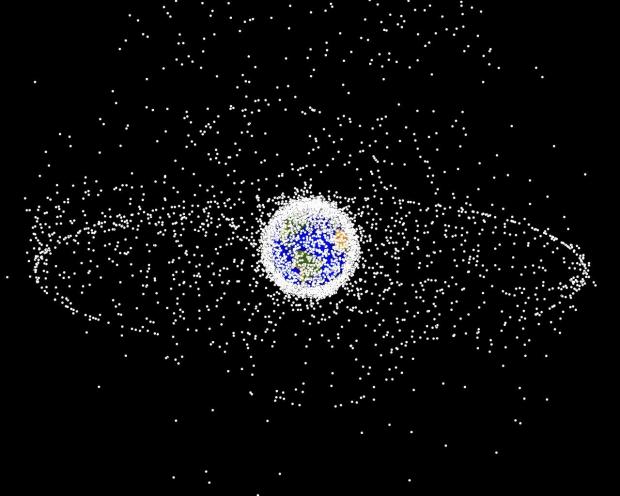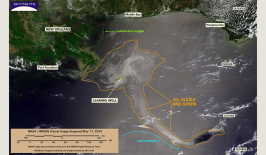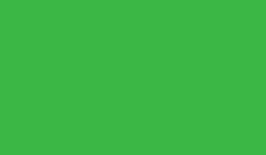Today, there are a huge number of satellites orbiting the Earth – around 6,000 of them in total – but only about half of them are still operational. When satellites and other spacecraft are no longer functional, they’re sometimes just left in orbit at the end of their mission. These and other traces of human activity in space crash into each other at high speeds and continue breaking down into smaller and smaller pieces – and these tiny pieces also continue to travel in orbit. According to models from the European Space Agency (ESA), by now there are more than 34,000 larger objects (10 centimetres or larger), 900,000 smaller ones (1 to 10 centimetres), and 128 million tiny objects (1mm to 1cm) whizzing around the Earth at speeds of up to 25,000 kilometres per hour.
And while the number of Earth satellites has increased rapidly in recent years, mainly due to private initiatives such as OneWeb or SpaceX, the problem has intensified. SpaceX alone plans to release tens of thousands of satellites into orbit in the coming years.
Of course, many of the satellites provide us with valuable services. The information and services that reach us via satellites have become an indispensable part of our everyday lives. And when it comes to protecting our environment and tackling climate change, too, satellite missions can provide new insights and help us, for example, to better understand complex interrelationships, to develop more effective protective measures and to track deforestation or reveal companies that are polluting the environment. But what is actually the issue with space junk? And what can we do about it? We talked about the topic with Holger Krag, who heads the space safety programme at ESA (the European Space Agency).
Holger, how dangerous is space junk?
Everything we have ever left behind in space is travelling at very high speeds. Satellites usually move at seven kilometres per second, which is about 25,000 kilometres per hour. And everything that breaks off satellites continues to move at that speed in space. And at that speed, even a piece just a few millimetres in size becomes a projectile that can destroy satellites costing millions. In a worst case scenario, not only do satellites stop working, but they can also actually break apart, creating even more debris. And those pieces of debris can then cause new collisions, so that in the end it’s maybe not just one satellite that is lost, but instead it triggers a cascade of collisions (the so-called Kessler syndrome, editor’s note), which is constantly filling outer space with pieces of debris.
The other danger is that the objects will also re-enter the atmosphere at some point and then we will be affected here on Earth. Nothing has happened to anyone yet, but we also have more space activity now. In the past, there were about a hundred satellites launched per year, but we’ve entered a new era now and the number has suddenly reached the thousands.
For me personally, the problem in space, i.e. collisions with objects, is the more importnt issue, because even if human life is not directly affected, we are very dependent on space travel now. Half of the apps on our smartphones, for example, are related to data from space. That’s everything from television broadcasts to phone calls themselves to weather forecasts and, of course, navigation. And we jeopardise the availability of services like that if we don’t make space travel cleaner.
How likely is it that someone could get hurt?
There’s not much left of a satellite when it re-enters the Earth’s atmosphere. Small pieces of debris disappear completely. And of the larger satellites, more than half usually disappears as well, because satellites are mostly made of aluminum or plastics, and they melt when they re-enter the atmosphere. Tanks or jets that are made of very heat-resistant material like titanium or stainless steel can survive re-entry, but those are completely slowed down and fall down at a normal terminal velocity.
There are a huge number of satellites and pieces of space debris orbiting the earth right now. Are there also ecological concerns about that?
That’s a very interesting question and I often debate it with students. Because the question is: Is space itself worth protecting? I think you have to distinguish problems in space from problems on Earth. If we are negligent with our waste on Earth, then we are not only endangering humanity, but also nature and other living creatures. But I am of the opinion: There is no one else in space. At least not in near-Earth space, where we are and where we do our space travel. So, pollution in space primarily endangers ourselves, as the people operating in space.
In the case of many environmental problems on Earth, the person doing the polluting is a different person from the one who suffers the consequences. That’s different in space. But there is a time factor too. If we leave something at an altitude of 1,000 kilometres, where there are no natural forces to break down the object, then it will remain there for all eternity.
Another question is whether we have the right to change the night sky. We get a lot of reports now about satellite sightings moving across the sky as little dots. Thirty years ago, I was still excited about being able to see the satellites, but when I look up today, there’s so much that’s moving around. So it’s a cultural issue: Do we have the right to an undisturbed view of the sky? Whether we are allowed to permanently change the view of the sky, that’s not something that should be left up to individuals to decide – especially since it’s something that also influences astronomical observations.
How do you locate the pieces of space debris?
That requires quite a bit of effort. They’re not intact satellites that send out a “here I am” signal. We have to actively track them down – and we’re talking about objects the size of a pencil, because that’s the size that you can see from the ground, about 10 cm. We beam towards these from the ground with radar. To do that, you need radar systems with several megawatts of power. But it’s not enough to see the objects only once; we have to repeat and remeasure this regularly, because the orbits – the paths on which they move – shift slightly due to various influences. And we want to know exactly where they are, because ultimately we want to be able to manoeuvre our satellites around those objects.
We also use telescopes, the same ones astronomers use for stargazing. These are passive telescopes, which in principle capture the sunlight reflected by the satellite. With those telescopes, it is possible to determine relatively accurate positions and then use complex computational models to predict where the objects will be tomorrow.
Doesn’t constantly monitoring space junk like that use a lot of energy?
It does. Several megawatts of radiating power are needed. But I haven’t looked into that aspect very much yet. At ESA have built a radar like this for the Spanish government. It’s in Extremadura. And there we are actually considering having a solar power plant, because that would be a good idea in that location. Of course, the radar has to work day and night. At night, you probably won’t be able to avoid taking electricity from the grid, but during the day, you could at least relieve the burden with solar power. It’s a question of money too. Especially in an area like Spain, where the sun is basically freely available on tap, it would be make sense.
How many objects are currently being monitored in this way?
We’re currently doing this for 23,000 objects. Everything above the size of about ten centimetres we can see, the smaller objects unfortunately not. But because most of the objects are the result of fragmentation, i.e. explosion and collision, it is easy to imagine that there are many smaller ones. We can assume that there are a million objects above the size of a cherry.
Are there similar numbers of objects found at all altitudes?
We are fortunate that in lower altitudes, remnants of the earth’s atmosphere can still be felt. And the Earth’s atmosphere has a braking effect, like the air resistance you feel when riding a bicycle. It’s much weaker, of course, but this effect is enough to force a piece of space debris at an altitude of 400 kilometres to re-enter within a year. At an altitude of 600 kilometres, however, where the atmosphere is thinner, the same object needs 25 years, at an altitude of 800 kilometers it takes 200 years, and above an altitude of 1,000 kilometers this effect disappears – the objects remain there for all eternity.
The biggest problem is actually at an altitude of around 800 kilometres. That’s an altitude that we like to use because the Earth can be observed very well from there. So we have higher concentrations on space junk at that altitude. Collisions have also happened at that altitude, four of them. The most famous one involved a collision between an Iridium satellite, which was still working at the time, and a non-functional Russian communications satellite traveling at 36,000 kilometres per hour. That collision alone created over 10,000 new pieces of debris.
What can be done to prevent even more pieces of space junk from accumulating in orbit?
One of the most important strategies is to bring the space objects down as low as possible after operation through their own means, for example, through the propulsion system that many satellites have on board. We say that 25 years is actually the longest time that satellites should stay in space. Satellites that don’t have a propulsion system on board, such as the small cube satellites that many universities have, should not be launched at such high altitudes at all. That’s important. If we do those things, then we can stop the number of pieces of debris in space from increasing. But they’re not happening, unfortunately.
There is also no real binding international agreement to regulate it, is there?
No, there is no international law that requires that. Each country is legally responsible for the objects that are launched. And it doesn’t matter whether it’s launched by a company, a space agency, or a university, the country where the company is located is responsible.
But we’re now in the era where national legislation is emerging all over the place. The pioneers are the Americans, the British and the French – they’re already including avoidance measures. Here in Germany we do not have a space law yet, but the coalition agreement already states that something like that is to be developed. This means that many countries are slowly following other countries’ lead. But every country will have to join, otherwise we run the risk of legal islands emerging – places that allow for “dirty” space travel.
The situation needs to be monitored, of course, and that’s where I still have concerns. Because currently, more than half of the projects still fail to implement appropriate measures. That has to improve.
But as well as developing national and international agreements, it’s also about finding technical solutions.
Yes, because de-orbiting a satellite is one of the most challenging parts of a satellite mission. And it is very likely that something will go wrong. So we need additional technology, for example an independent propulsion system that is installed from the outset and can be commanded separately from the ground, in other words a kind of package that is tied onto the satellite. We call this a “de-orbiting kit,” and it can be used to initiate a de-orbiting manoeuvre even if the satellite no longer responds. That’s the kind of thing we’re developing.
What is the current status of the de-orbiting kits?
We are now at a stage where we’ve already demonstrated certain aspects of the technology in space. I think we will be ready relatively soon to fly an “uncontrolled re-entry”, which means that we can lower an object in orbit, but cannot predict exactly where it will re-enter. We’re still working on controlled re-entry. We assume that this will be available to us in perhaps five to six years.
Is ESA also developing other solutions to clear the orbit of retired satellites and debris?
Yes, we are also planning active retrieval. In other words, a mission that has the task of flying up to a large, particularly critical object, grabbing it and then disposing of it in a controlled way.
Could you explain a bit more how that works?
It’s a gripping device that consists of four symmetrically mounted arms. The arms move simultaneously, so there is no reaction torque on the satellite, making it simple to control. The arms enclose the object before touching it, because each touch causes momentum transfer, which has a reaction effect. This is difficult to control from the ground. So first the object is secured and then it’s touched. Then it’s pulled tight to the body of the satellite so that they can be decelerated together. We plan to demonstrate the technology by 2025.
That’s very soon for what sounds like a very complex technology.
That’s right, it’s very complex and has never been done before. We’re investing a multi-million euro sum in developing the necessary technology right now.
The first retrieval mission of an ESA object is set to take place in 2025. The mission will be carried out by a small Swiss startup that plans to make this a commercial venture later on. But for projects like this to be worthwhile, there are still many more steps that have to be taken. Today, lawmakers still aren’t even insisting that missions like this be carried out. There is readiness, but the technology has to be there and it has to be cheap. In this case, we see it as our duty to move things forward in the hope that lawmakers will stipulate that a “collection service” like this will have to be used in the future for satellites that cannot be properly disposed of otherwise.
But isn’t it easier to focus more on the development of “de-orbiting kits” than on costly retrieval missions?
Yes, but the development times are still very long right now, so there will be many more objects sent out that haven’t yet equipped with it.
And testing the technology is also worthwhile in terms of another gap in the market: When a functioning satellite runs out of fuel, its mission is over because it can no longer maintain its position and orientation. That means you have to throw away equipment costing millions just because the tank is empty. So why not use missions like this to extend the service life of satellites? You need the same technology to do that: namely, to be able to approach an object and grab it. In that respect, it is worth investing in orbital capabilities.
It’s expensive, of course. You have to get the price down, but you also have to remember that the damage is much greater if you do nothing. It’s the same when it comes to climate change. It’s cheaper in the long run for our generation to take action than it is for us to wait and take action 50 years from now.
This is a translation of an original article that first appeared on RESET’s German-language site.
This article is part of the RESET Special Feature “Satellites for Sustainable Development”. Click here to explore all of the articles in the series.









